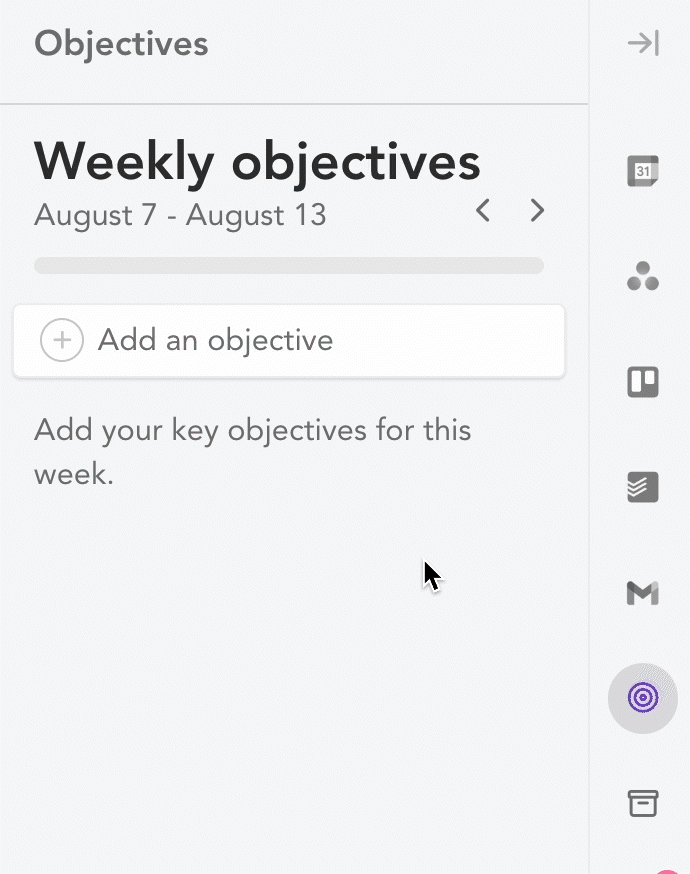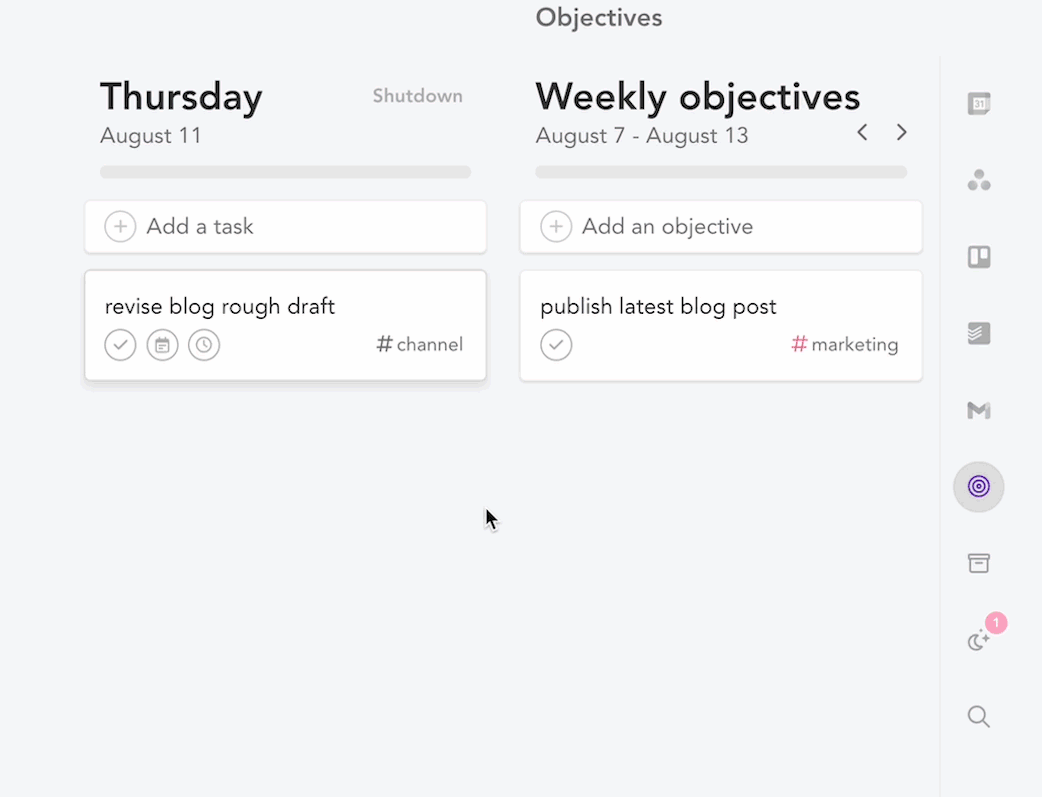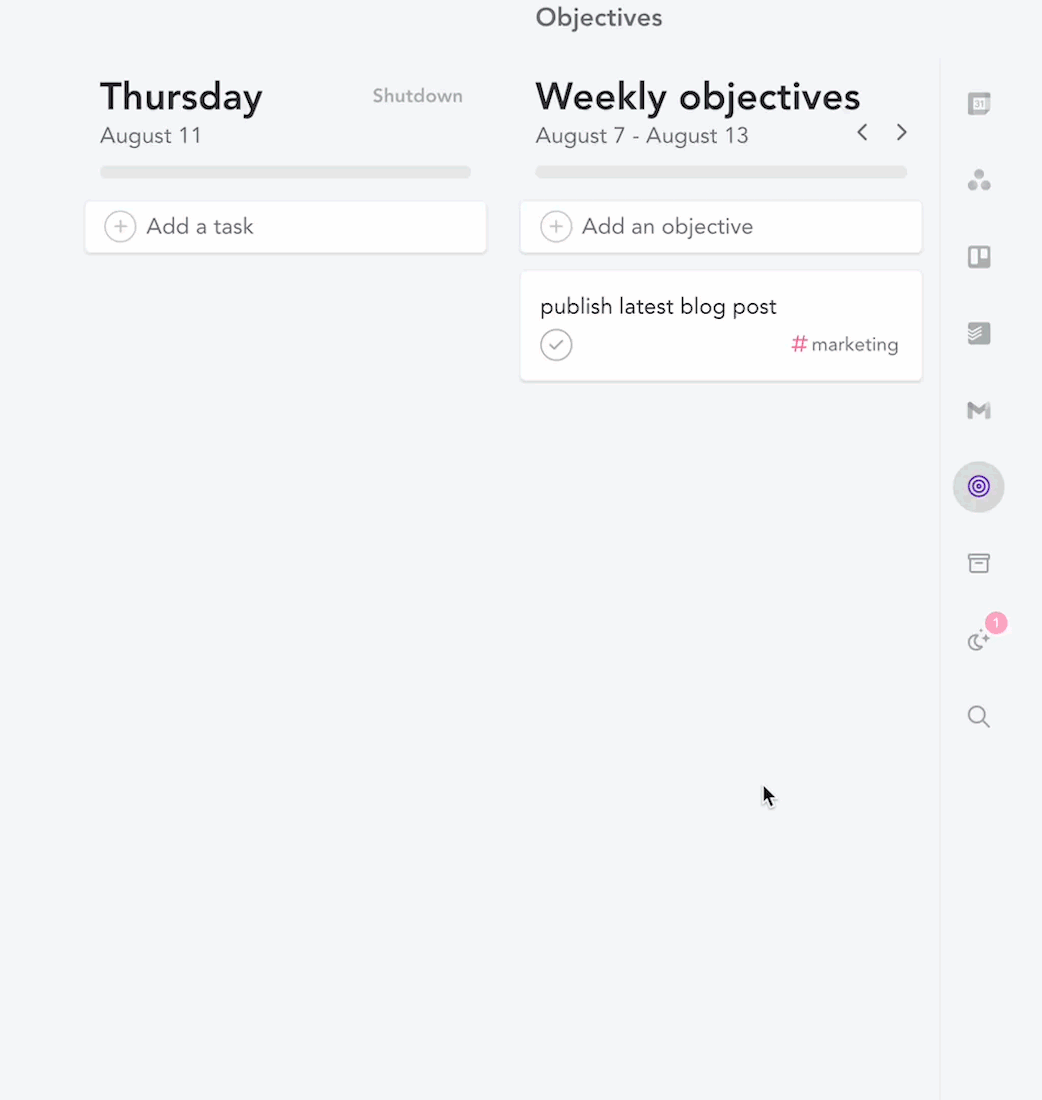Weekly Objectives
Purpose:
Objectives have a similar look and feel to tasks, but serve a slightly different purpose. Your objectives should define your priorities or main goals for the week.
Use objectives for longer tasks that may span multiple days and/or involve several distinct tasks.
Walkthrough
How to use:
Accessing your weekly objectives · 0:11
To open the weekly objectives panel from your main workspace, click the purple bullseye or “target” icon in the right hand panel.
Creating weekly objectives · 0:20
To create a weekly objective from the Objectives panel, click “Add an objective”. Then type a name for your objective and hit enter.

How to align a task with a weekly objective · 0:30
There are two ways to align an existing Sunsama task with one of your objectives:
- highlight, hover over, or click on a task and type the keyboard shortcut
R· 0:37

- or, click into a task and click the three dot “other actions” button and click “Align with objective” · 1:11

You’ll then be able to select which of your objectives you wish to align the task with. Once you align a task to an objective, the task will have a purple target on it to visually indicate that it is aligned with an objective.
How to turn an existing task into an objective
Follow the same process as you would when aligning a task to an existing objective. In the drop down menu, you can create an objective from from a task by clicking "Turn this into an objective".

How to create tasks from a weekly objective · 2:02
You can also create tasks directly from a weekly objective, which will automatically be aligned with that objective.
There are two ways to create a task from a weekly objective:
- simply drag the objective into a daily column · 2:09

- or, click on your objective and then click on a day of the week and add planned time. · 2:23

This will create a task with the same name as the objective on the day of your choice.
Notes:
- If you create a task from an objective to a previous day, you’ll be adding “actual time” rather than “planned time”, as the task would have already been completed.
- You can add a task directly from the objective on multiple days of the week, and multiple instances per day.
- You can change the name of these tasks created from the weekly objective and it will remain aligned and not change the name of the objective.
How to extend an objective to the next week · 3:00
If you’d like to extend an objective to the next week because you weren’t able to complete it this week, you can do that by:
- Clicking the objective
- Click the “Extend” button and choose “Extend one week”.
That will extend the objective into next week’s list of Weekly Objectives. It will also still remain in the current week.
Notes:
- You'll have the option to more seamlessly extend your objectives during the Weekly Planning ritual.
- You can extend an objective one week at a time indefinitely.
- If you’ve already extended an objective, you can remove the extensions by clicking “End: next week” and clicking “Remove extensions”.
- You can defer or move the objective to next week or next month by clicking “Start: this week”.
How Channels work with Objectives · 3:46
You can assign your objective to a channel.
When you align a task to an objective, the task will inherit the objective’s channel if the task wasn't already assigned to a channel. When a task already assigned to a channel is then aligned with an objective, it will preserve its original channel instead of inheriting the channel of the objective.
If you change the objective’s channel, all aligned tasks will update to align with that new channel.
You can change the task’s channel to a different channel than the objective.
If you create a task directly from the objective, it will automatically have the objective’s channel.
Best practices:
- At the start of the week, spend a few minutes deciding what your priorities are for the week ahead with the Weekly Planning ritual. Review your objectives at the end of the week, or when you plan for the week, with the Weekly Review ritual.
- During your daily planning, review your objectives. If you see one you want to work on, you can create a task from it. Your objectives should help ground your choices about how to spend your time.
- It’s best to not have too many objectives. This is not the place for a large list of your goals overall, nor are these meant to be individual tasks. Think of them as the main goals you want to accomplish in the week.
- Objectives are a great way to group related tasks. For example, if you plan to write a rough draft on Tuesday, revise the draft on Wednesday, and publish the article on Friday, you could align all of those tasks to a “Publish article” objective.
- The purple bullseyes on your task cards show which tasks are your most important ones that link back to your objectives.
Troubleshooting:
- The objectives that are displayed correlate with the day currently in view in the main Kanban. If you navigate to a day in a different week, you’ll view the objectives from that week. You can also navigate week-by-week with the arrow buttons next to the weekly objective
- The list of objective-aligned tasks in the right hand Objectives panel is limited to 10. If you have more than 10 aligned tasks to an objective that week, just click to open the objective and view all aligned tasks.
- If you are in a shared collaborative workspace with teammates, know that teammates cannot view, edit, create, or assign each other’s objectives. If you want your team to be aware of your objectives, it’s best to share them via the weekly planning and/or weekly review flows.
Updated 8 months ago